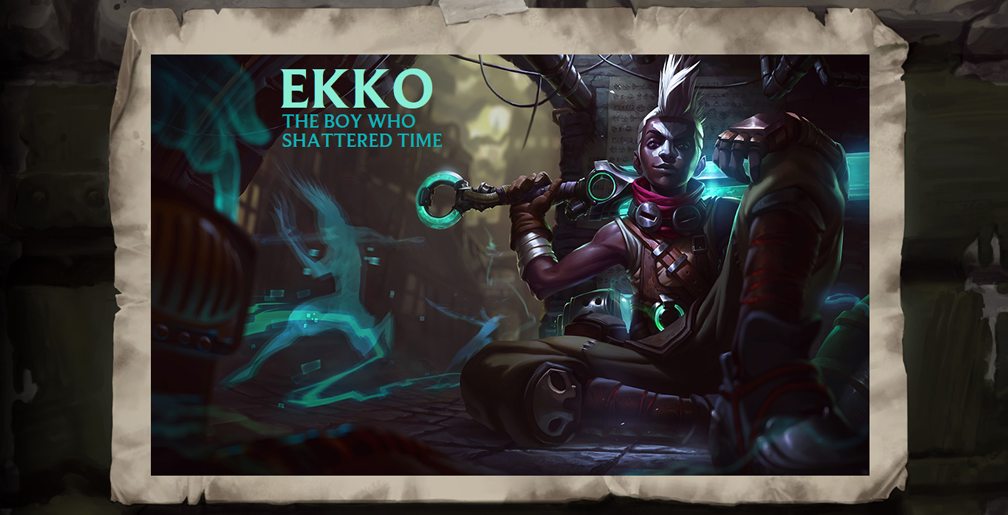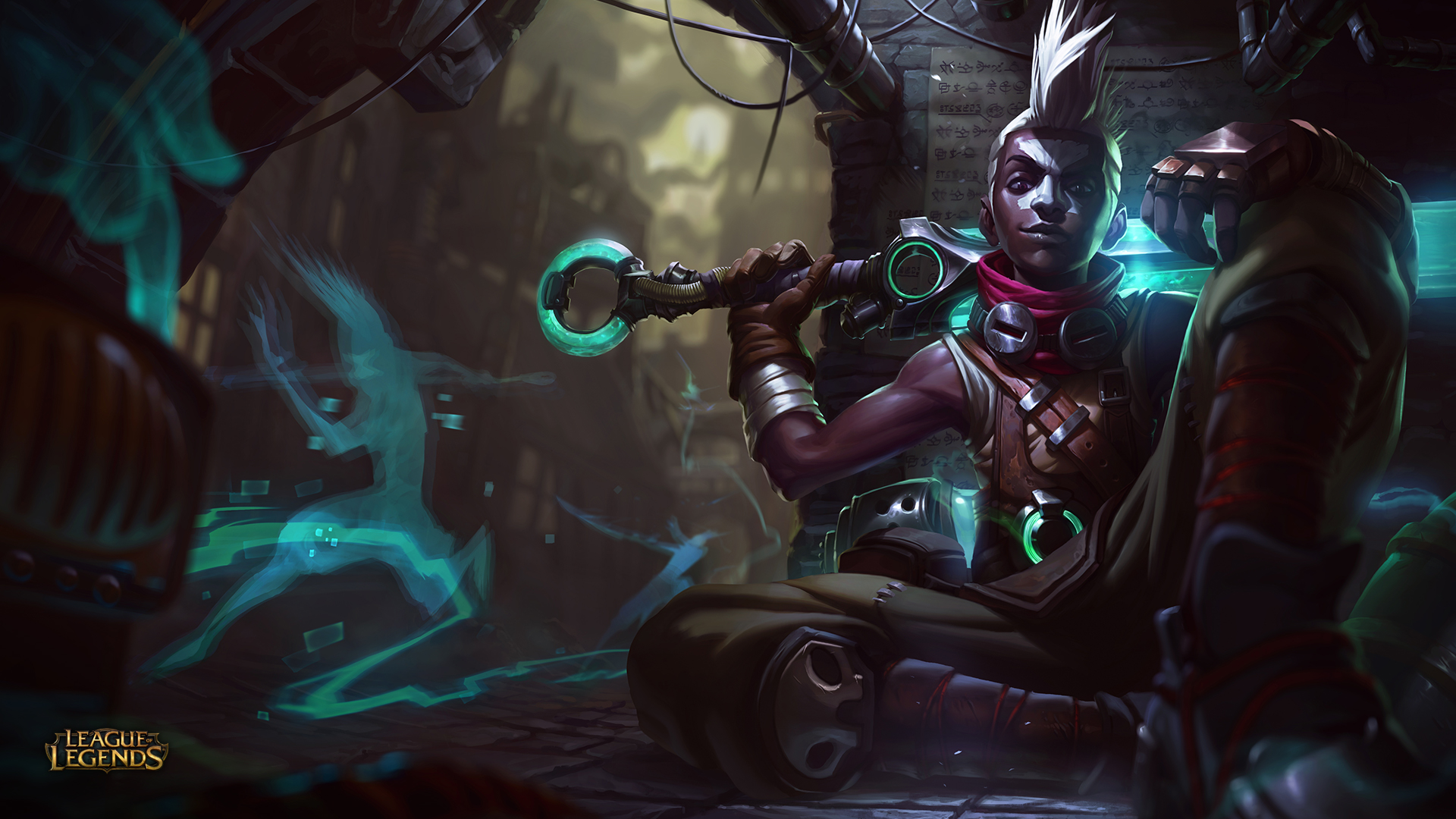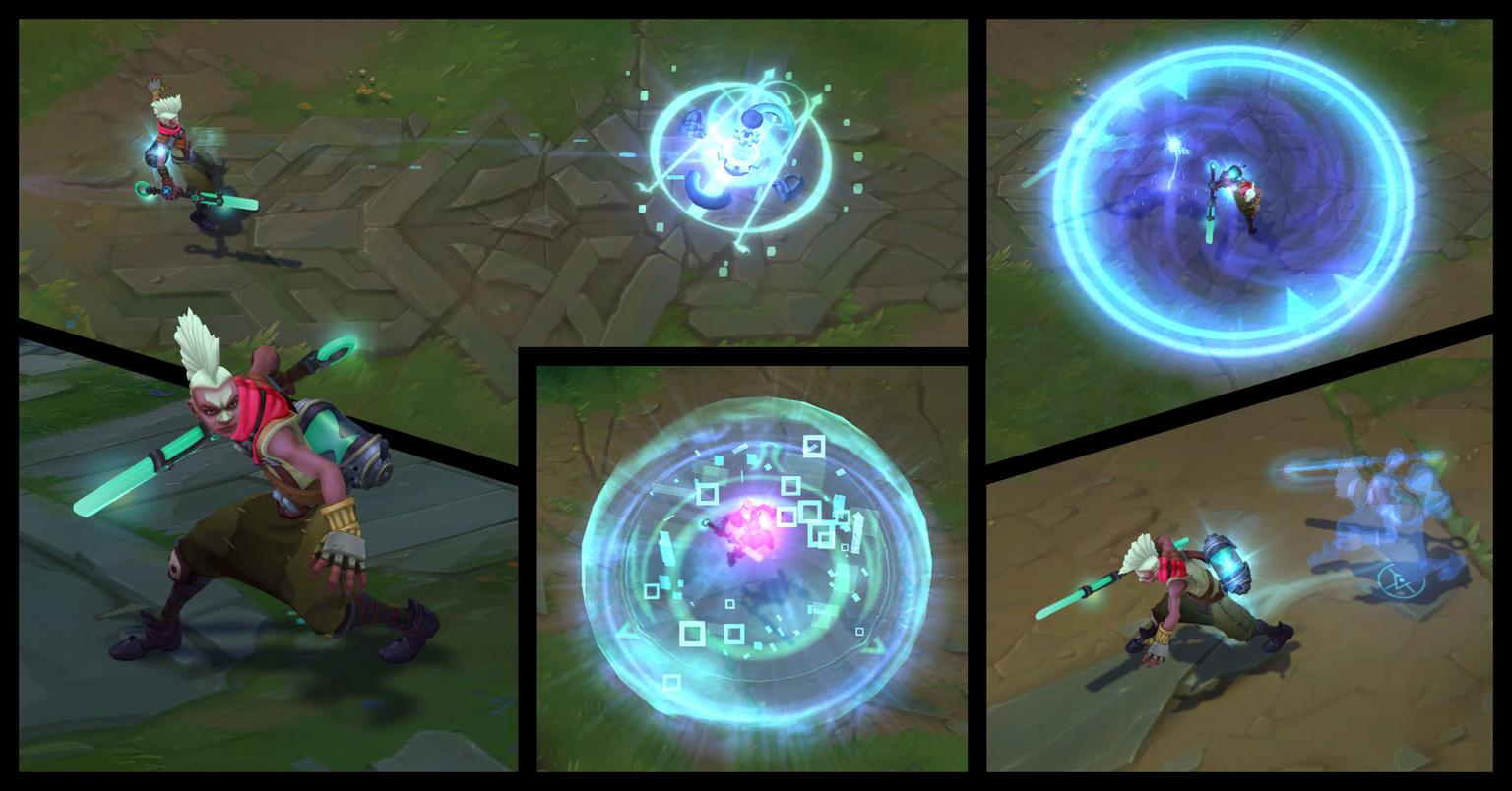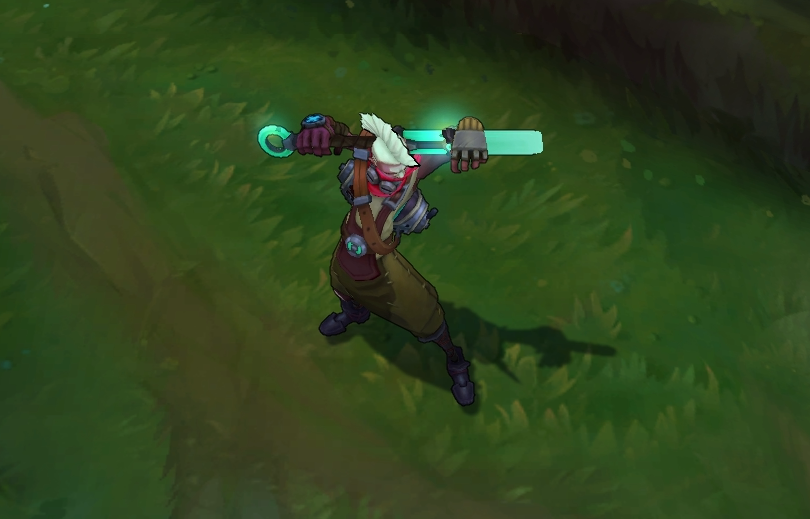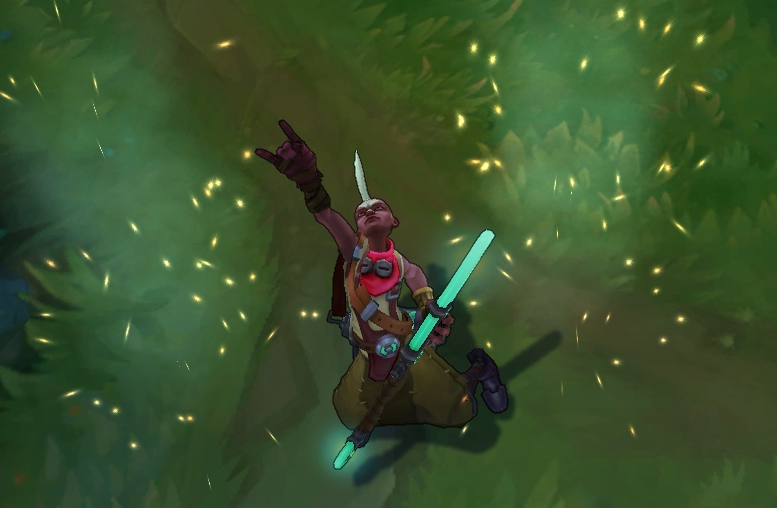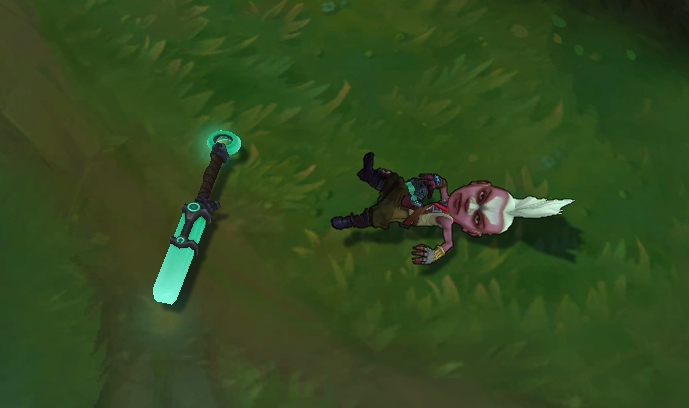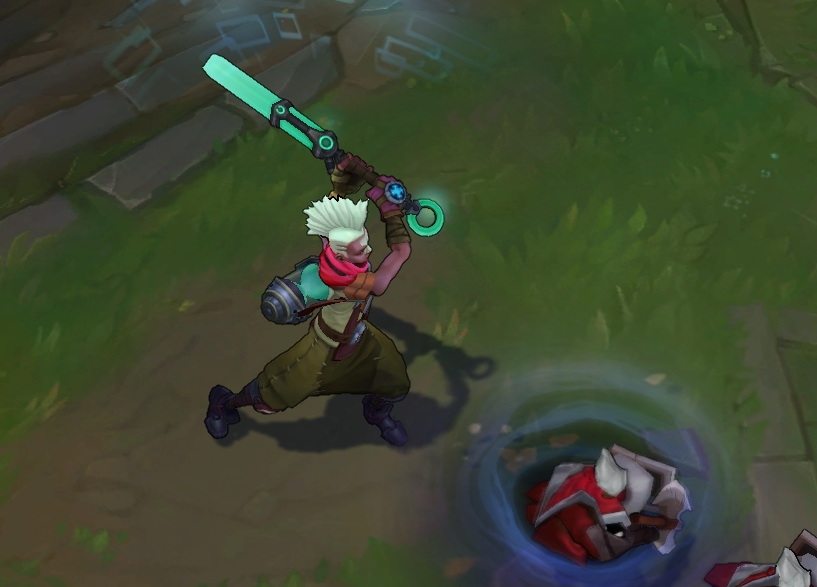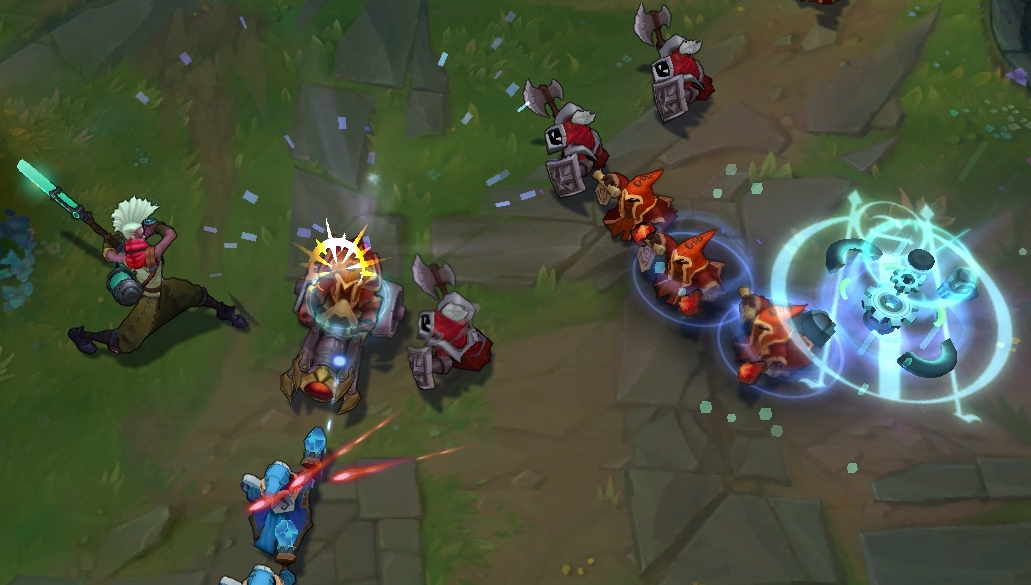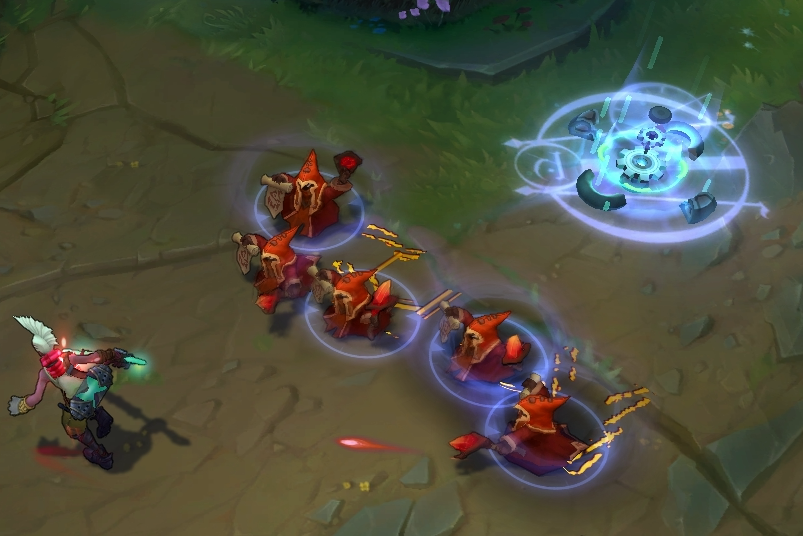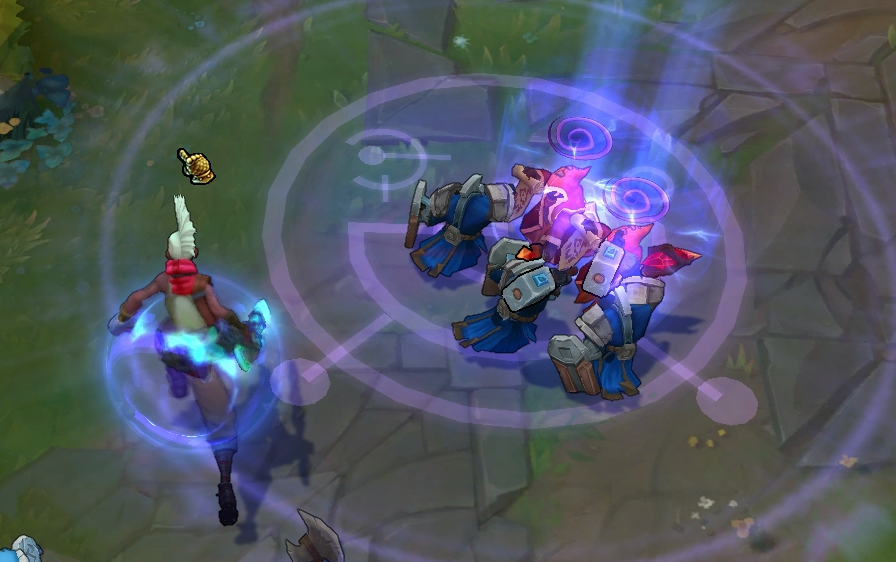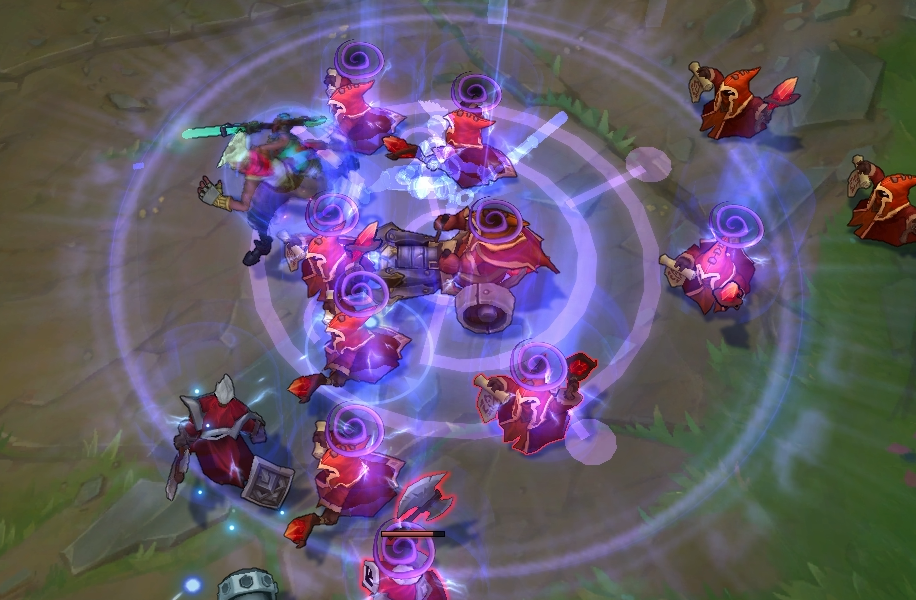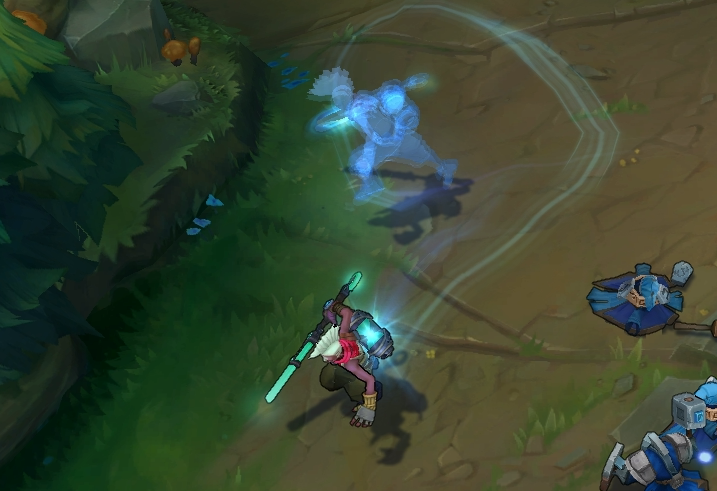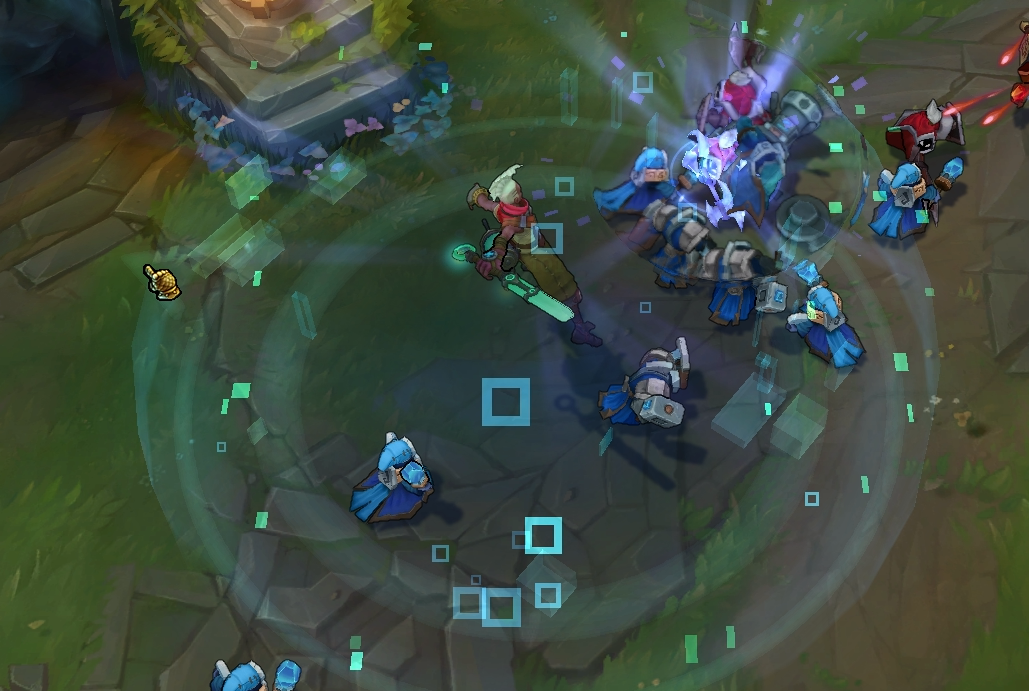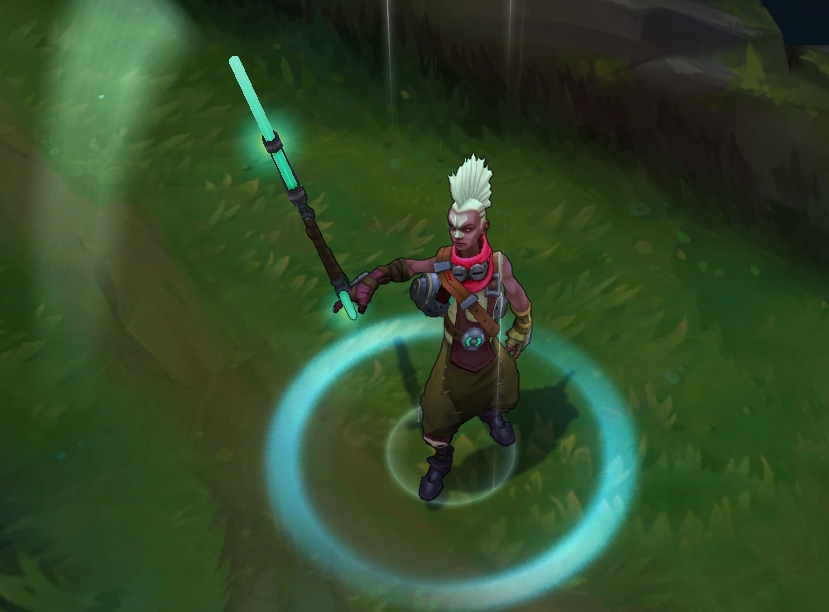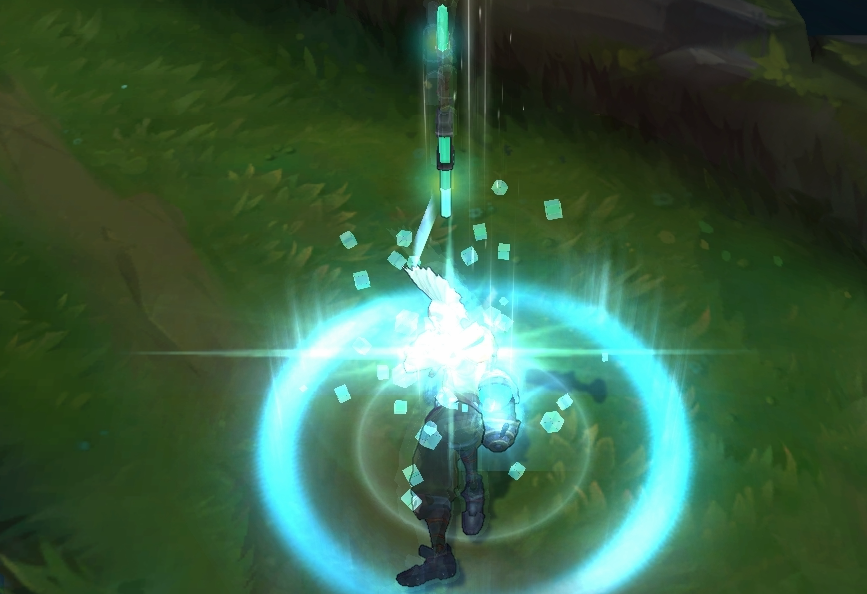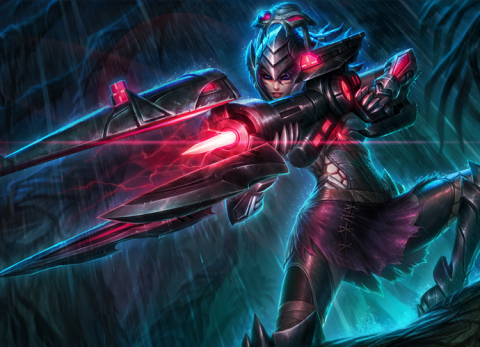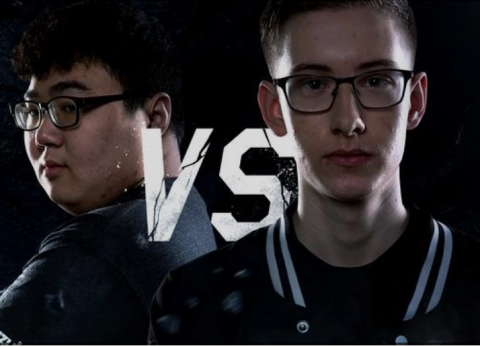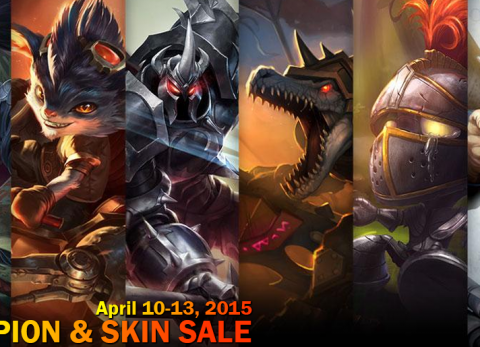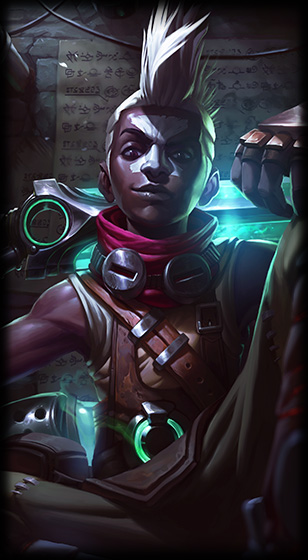
Abilities

Z-Drive Resonance (Passive)
Ekko’s Zero-Drive charges his spells and attacks with temporal energy. The third hit deals bonus damage and saps the target’s movement speed. If the target is a champion, Ekko gains accelerated movement speed.

Timewinder (Q)
Ekko throws a device that deals 60/75/90/105/120 (+0.2 AP) magic damage to enemies it passes through. It expands into a slowing field on the first champion hit, slowing everything inside by 32/39/46/53/60%. It then returns to him after a delay, dealing 60/85/110/135/160 (+0.6 AP) magic damage to all targets hit upon return.
Cost: 60/70/80/90/100 Mana
Range: 1075
Cooldown: 11/10/9/8/7 seconds

Parallel Convergence (W)
Passive: Ekko’s basic attacks deal bonus magic damage to enemies under 30% health equal to 4/4/4/4/4% (+2.857% per 100 AP (+20% at 700 AP)) of their missing health (max 400 damage vs. minions and monsters).
Active: After a 3 second delay, Ekko creates a short-lived chronosphere at the target location that slows enemies who enter by 40%. If Ekko enters the sphere, he will detonate it, gaining a shield that absorbs up to 150/195/240/285/330 (+0.8 AP) damage for 2 seconds. Enemies caught inside are stunned for 2.25/2.25/2.25/2.25/2.25 seconds.
Cost: 30/40/50/60/70 Mana
Cooldown: 22/20/18/16/14 seconds.

Phase Dive (E)
Ekko dashes a short distance in the targeted direction. His next attack will deal 50/80/110/140/170 (+0.2 AP) bonus magic damage and teleport him to his target.
Cost: 40/50/60/70/80 Mana
Range: 325
Cooldown: 15/13/11/9/7 seconds

Chronobreak (R)
Makes Ekko invulnerable and untargetable, and teleports him back to wherever he was 4 seconds ago. Ekko heals himself for 100/150/200 + 20/25/30% (+3.33% per 100 AP) of the damage taken over the last 4 seconds, and deals 200/350/500 (+1.3*AP) magic damage to all nearby enemies on arrival.
Cost: None.
Range: 850
Cooldown: 90/80/70 seconds
LANING
Ekko’s early game revolves around his ability to create windows of opportunity with Timewinder. Its decent range and sheer size makes it a powerful zoning and passive generation tool, although if Ekko isn’t judicious with his casts, he’ll quickly run both out of mana and into trouble. Aside from farming, Ekko’s Q also provides poke against his lane opponent, particularly when he Phase Dives, repositioning himself to strike his target with both rounds of Timewinder. Smart positioning should gift Ekko with a perfect window to hustle in with Phase Dive’s blink and pressure his target with mounting Z-Drive Resonance stacks. And, after diving on top of his opponent and triggering his passive, Ekko can simply run out, making the most of his speed boost as he heads to safety.
Ekko’s role as a solo lane skirmisher becomes increasingly apparent as he starts leveling up and unlocking his full repertoire of abilities. Accurate Parallel Convergence casts – especially used against enemies slowed by Timewinder – give him great trading windows: landing it on his lane opponent gives Ekko the chance to phase in and trigger W’s stun for a couple of free attacks. Even if his target avoids the crowd control, they’ll still have a hard time successfully trading thanks to Parallel Convergence’s shield.
Once his opponents see potential power of the ability, Ekko can get psychological, using his W casts to zone his enemies away from last hitting or force them towards an approaching jungler. He can even wrangle a couple of defensive uses out of Parallel Convergence, like triggering the ability’s explosion just so he can shield himself from otherwise lethal damage, or casting the ability directly on himself as enemy junglers come in to gank. This forces his would-be killers to choose between backing off, and stunning themselves within arm’s reach of the boy from Zaun.
Ekko’s skirmishing and trading turns stronger still after he unlocks Chronobreak, gifting him the chance to heal up and try again after unfavorable trades, or use the ability to blink inside Parallel Convergence’s stun sphere to trick his lane opponent. Chronobreak comes packed with plenty of utility, too – if he’s nimble enough, Ekko can simply hit his ult to escape from deadly gank situations, or just return to lane if he’s a speedy shopper after recalling.
SKIRMISHING
Ekko lacks the raw power to burst his targets down, so relies more on his cunning than his strength. As the two teams start gathering, he needs to look for opportunities to skirmish, harassing and chipping away at his targets from relative safety. Timewinder’s an important component here, offering Ekko his best method for developing his Z-Drive Resonance stacks as his enemies group. All the same, he has to be careful to avoid being poked out himself or caught by enemy crowd control abilities – as slippery as Ekko is, he’s not a resilient champ, and will quickly bite the dust once caught. But if a pick opportunity presents itself – if an enemy is already wounded or they’re far enough away from their disruptive allies – then Ekko has all the tools, gadgets and gizmos he needs to get in, secure the kill and fall back in relative safety. Here’s where Parallel Convergence comes in.
By placing the ability’s sphere between his target and their allies, Ekko effectively zones them, forcing them to either move farther from safety, or willingly enter into Ekko’s trap. Either way, an accurate Timewinder should slow the target enough for the boy from Zaun to Phase Dive in and start bludgeoning his target. Once he’s reduced their health enough, Ekko’s damage amps up pretty significantly thanks to Parallel Convergence’s passive, making low health enemies especially enticing. And once he’s done his work, he needs to quickly make his way to safety; if he’s up past his neck in trouble, he can push his big red button and Chronobreak to reappear with his team.
TEAMFIGHTS
Ekko takes on a different role in large-scale teamfights, thriving in situations when he can follow up on high-impact area of effect abilities. After setting up his team’s initiation with Timewinder, Ekko follows up with Parallel Convergence before Phase Diving into his sphere to stun his enemies and shield his butt before he starts swinging his club. Then it’s a matter of timing: Ekko needs to carefully balance the level of his health against the impact of his ultimate. Trigger Chronobreak too early and he’ll end up back in his own team’s backline; too late and he’ll already have met his maker. But when Ekko Chronobreaks correctly, when he reappears in the heart of the enemy team with topped up health and a devastating amount of area of effect damage, then his team all but wins the fight.
SYNERGY
Mini Gnar and Ekko work together well enough – their combined long range slowing damage from Timewinder and Boomerang Throw fully capable of poking down most enemy champions. But Ekko thrives when Gnar goes Mega, blinking in with Phase Dive to follow up the Gnar! crowd control train with Parallel Convergence before casting Chronobreak to rewind time and roll in once again on whoever Mega Gnar hasn’t yet battered to death.
Similar to Gnar, Vi has plenty of lockdown that Ekko can take advantage of as he dashes in to claim kills. However, unlike the Missing Link, Vi packs a punch of her own, and when she starts roaming with Ekko, the two pair into a devastating duo with enough firepower and crowd control to take down most enemies with ease.
Draven might be one of League’s most powerful early game marksmen, but he sorely lacks the crowd control he needs to hold his enemies down as he can slings his axes. That’s where Ekko comes in. By roaming bot and placing Parallel Convergence between the enemy marksman and their tower, Ekko forces his target towards Draven or into his trap. And even if they somehow sidestep Parallel Convergence, Ekko can fire out Timewinder for a heavy slow. Either way, the blood brother with the glorious ‘stache gets a kill.
STRUGGLES AGAINST
Chronobreak’s a powerful tool, particularly when Ekko plans his ult use ahead of time. However, in the face on high damage, bursty champions, Ekko can often lose trades so hard that he’s forced to use Chronobreak just to stay alive. LeBlanc, with her high damage and low cooldown abilities, can often force Ekko’s hand, removing one of his strongest trading abilities from his repertoire for a good while.
Ekko copes just fine when he can actually dart in and out of combat, applying damage before suffering too much back. Unfortunately for him, Fiora has a few ways to overpower the trade and win most duels. After parrying Ekko’s gambit with Riposte, Fiora can force the fight with two casts of Lunge before using Burst of Speed to hack poor Ekko down. Even if Ekko tries to Chronobreak away, Fiora can stick with him with a well-timed Blade Waltz.
Parallel Convergence and Timewinder both slow enough for Ekko to catch up with most enemies, but Graves has a few tricks up his shotgun to help him keep distance and win trades. Smoke Screen will effectively nullify Ekko’s second dash if placed correctly, and even when Ekko’s able to close range, Graves can fire out a max damage Buckshot before using Quickdraw to kite away.
CHAMPION INSIGHTS
Ekko, game design by gypsylord
In his lore, Ekko’s a smart guy who uses his wits to survive the streets of Zaun. I wanted to reflect that in his gameplay by making him feel wily and clever, so I asked myself how we could make an assassin who doubles down on feeling smart. We already have a bunch of ways for players to feel skilled in League: Ezreal players feel skillful when they land their skillshots, while Janna players might feel skillful when they combo their abilities together in the right way to save their carry. Getting players to feel smart, on the other hand, is a trickier beast. Here’s a contrast: Zed players are skillful when they position correctly, engage on their targets and land all their abilities. Zed players are smart when they lead enemies on a wild goose chase and then teleport back to a shadow they left behind at just the right moment. The core thing here is feeling like you came out ahead in an engagement through solid situational analysis instead of raw mechanics and reaction time.
Now for Ekko. He feels smart through the idea of predictive gameplay. Basically, instead of reacting to what happens, I wanted you to feel good about predicting what will happen – call the shot right and you get a reward. This is best represented in Ekko’s W, Parallel Convergence. The ability asks him to take in his current surroundings and make a call as to where he will need to be in three seconds. If he does it right, he gets a shield, but if he does it extra right by also calling out where his enemy is going to be, he gets to stun them. The time between cast and detonation starts a game where Ekko and his team need to move in just the right way to ensure everyone goes where he wants them to. Timewinder is similar. At one point Ekko was able to call the Q back manually at any time during the cast, but while this made the ability feel more mechanically complex, it made Ekko’s use of it less smart. There was no longer a contextual problem to solve, and the use case just became a flat yes/no question. Will the orb hit them? If yes, recall it. Without the mechanical complexity, Ekko has to plan how he’ll use his Q, and reposition himself so that both damage rounds land against his target. It’s smarter.
A second “smart gameplay” idea we wanted to implement in Ekko’s kit was abilities that have a basic functionality, but which can also be used perfectly for much greater effect. Ekko’s Parallel Convergence again fits in here. It creates a reasonably large area that enemies don’t want to be in, so at its base level, it works as a zoning tool. Similarly, Ekko can cast the ability on himself for a shield – another base level use for the ability. But in order to land the stun, he needs to figure out how he or his allies can lock his target down and keep them in the zone. Analyze or force the situation correctly by orchestrating your enemies and allies into the sphere, and you win the teamfight.
The second question we explored on Ekko was figuring out how we could make an assassin feel good when they’re not one-shot killing targets? We already have kill assassins (Zed and LeBlanc, for instance), so we came up with the idea of a utility assassin. Ekko, like Ashe, has lower ratios and so takes longer to secure kills than most in his role. But where he loses damage, he gains large amounts of CC that he can use to win teamfights even when he isn’t the main damage threat. Basically, if Zed can’t kill Anivia, he can’t kill Anivia – he doesn’t provide much else to his team. But if Ekko can’t kill Anivia, he can at least try to lock her (and maybe her team) down so people like Jinx can clean up. Thanks to Chronobreak and Phase Dive, he’s still very good at taking risks, and is heavily encouraged to take multiple passes at a fight if things don’t go perfectly the first time.
Finally, you might be wondering why you’d want to pick an assassin who can’t kill people. That’s actually untrue – if any squishies on the enemy team gets low Ekko can and will find and kill them thanks to the assassin threats that Ekko does retain, specifically his ability to select single targets with Phase Dive before using the execute damage on Parallel Convergence to kill them. Ashe is still a marksman, and Ekko’s still an assassin – they’re just a little different.

